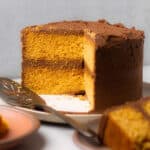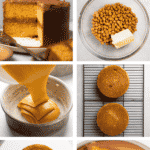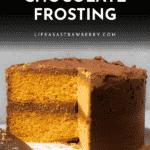Description
This cozy butterscotch cake is perfect for fall!
Ingredients
To prep the cake pans:
- 1-2 Tablespoons softened butter
- 2 Tablespoons flour
For the cake:
- 175 grams butterscotch morsels (1 cup)
- 4 Tablespoons unsalted butter (55 grams)
- 210 grams all purpose flour (about 1 ⅔ cups)
- 50 grams brown sugar (¼ cup packed brown sugar)
- 5 grams baking soda (1 teaspoon)
- 2 grams kosher salt (½ teaspoon)
- 240 grams milk (1 cup)
- 12 grams apple cider vinegar (1 Tablespoon)
- 4 grams vanilla extract (1 teaspoon)
- 1 egg
For the frosting:
- 140 grams butterscotch chips (3/4 cup - just the rest of the bag)
- 2 Tablespoons unsalted butter (27 grams)
- 300 grams powdered sugar (3 cups)
- 45 grams cocoa powder (1/2 cup)
- Pinch of salt
- 80 grams heavy cream (1/3 cup)
Instructions
Prep the cake pans:
- Spread softened butter over the inside of two 6-inch cake pans, then dust the inside of each pan with a spoonful of flour and discard any excess. Set aside.
- Heat oven to 350° Fahrenheit.
For the Cake:
- Melt butterscotch morsels and butter together over a double boiler, making sure the top bowl is not touching the water below. Keep the double boiler on low heat, stir frequently, and remove the butterscotch as soon as it's fully melted (this should take about 10 minutes). Note: Butterscotch chips won't melt as smoothly as chocolate does - this mixture will look a bit grainy and greasy. This is ok!
- While the butterscotch chips melt, whisk flour, brown sugar, baking soda, and salt together in a large mixing bowl. Set aside.
- In a separate, medium mixing bowl, whisk together milk, apple cider vinegar, vanilla extract, and egg. Set aside.
- When butterscotch is melted, remove it from the double boiler (we like to place the warm bowl on a tea towel on the counter). Let cool 5-10 minutes, then slowly whisk butterscotch mixture into the rest of the wet ingredients (the milk and egg mixture you made before). Note: Set aside the bowl you used to melt the butterscotch - you can re-use it for the frosting later!
- Stir butterscotch mixture into the dry flour mixture until you have a smooth batter.
- Divide batter between prepared cake pans. Bake at 350° F for 25-35 minutes or until a cake tester inserted into the center of the cake comes out clean.
- Let cake cool in the pans for a few minutes, then tip cake out onto a wire cooling rack and let cool completely before making the frosting.
For the frosting:
- Melt butter and butterscotch morsels together over a double boiler. Remove from double boiler and let cool 5 minutes or so until the bowl is cool enough to handle.
- Add powdered sugar and cocoa powder along with a pinch of salt to the melted butterscotch and stir to combine. The mixture should look quite clumpy right now - that’s ok!
- Use an electric hand mixer to mix frosting together as you add heavy cream a little at a time. Whip until frosting is smooth and fluffy. (You can do this by hand if you like, but we find an electric mixer works best for a light, spreadable frosting).
- Immediately frost cooled cake using an offset spatula. Frosting will stiffen a bit and be harder to spread as the butterscotch cools; work quickly for best results.
Notes
A note about butterscotch morsels. We like the Nestle Butterscotch Morsels (they're typically easy to find in the grocery store baking aisle, right next to the chocolate chips) but you can also find versions from Hershey's, Guittard, or the store brands at Aldi and Walmart. Please note: Butterscotch hard candies or caramels won't work as a substitute in this recipe - it's important to use the butterscotch morsels or butterscotch baking chips as listed in the recipe!
Please use a kitchen scale if you have one! Measuring by volume (with cups and teaspoons) is notoriously unreliable - for best results (and the most delicious cake!) we recommend following our weight measurements (listed in grams above). If you don't have a kitchen scale, be sure to measure your dry ingredients (especially flour and cocoa) with the scoop-and-level method for the most accurate results.
How to melt butterscotch chips. We recommend making a double boiler to melt the butterscotch chips in this recipe. If you have a specialty double boiler pan, go ahead and use it - although we typically just fill a small saucepan with an inch or two of water and set a heat-safe glass or metal bowl on top to build our own double boiler at home. If you need to use a microwave to melt your butterscotch chips, microwave the chips and butter in a microwave-safe bowl in 5-10 second intervals, stirring well in between, and keep a close eye on them as they're prone to burning and separating in the microwave (but we really recommend using the double boiler for best results!)
If your butterscotch mixture seizes up and forms large clumps that you can't work out by stirring, it's likely been overcooked. If your butterscotch mixture goes from "slightly grainy/greasy" to "chunky and sludge-y," it may have gone too far and you may need to start over. This typically only happens when butterscotch chips are microwaved or sit over a double boiler on too-high heat for an extended period of time. You will also notice a burnt, bitter taste to the butterscotch if it's been cooked too long - when in doubt, give it a taste.
If frosting sets too quickly and becomes hard to spread, stir in another dash of heavy cream or pop it over the double boiler for a minute until it softens back up.
Additions and Substitutions. Use a different frosting if you like - chocolate buttercream, cream cheese frosting, and our chocolate fudge frosting are all good here. White chocolate chips work pretty well in place of butterscotch morsels in a pinch. Use white granulated sugar instead of brown sugar if you like. Use coconut oil in place of the butter if you prefer (be sure to measure the coconut oil by weight for best results). Use white vinegar instead of apple cider vinegar (just don't skip the vinegar - this activates the baking soda and helps the cake rise!)
Adjust the size of the cake. This recipe makes two 6-inch cake rounds, 12-16 cupcakes, or one 9-inch cake (in a square or round pan) as written. Double the recipe for two 8-9" cake layers or a large sheet cake. You'll likely have to adjust the baking time for different cake sizes.
Store leftover cake in an airtight container on the counter. It will keep for up to 5 days, but we find the texture is best if eaten within a day or two of baking (after that, the cake will start to dry out and won't be as soft or as moist). We don't recommend storing this cake in the fridge or freezer: cold storage can alter the texture and make the cake pretty dense.
A previous version of this recipe used a chocolate butterscotch ganache instead of this chocolate frosting. To make the original ganache, melt 3/4 cup butterscotch chips with 1 Tablespoon butter and 1 1/2 cups semi-sweet chocolate chips over a double boiler until smooth, then pour over the cooled cake.
This recipe was originally posted in 2013. It was updated in 2022 with a streamlined recipe (same great taste, but easier to make!), additional notes and photos, and a new frosting recommendation. Inspired by Rose Levy Beranbaum's White Chocolate Cake Recipe in The Cake Bible.


